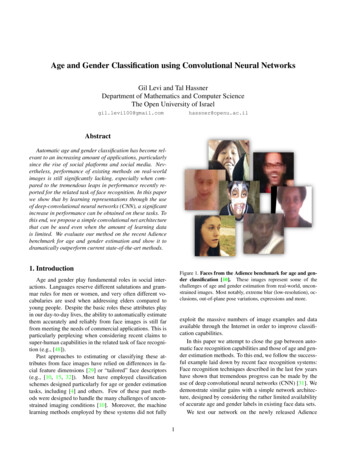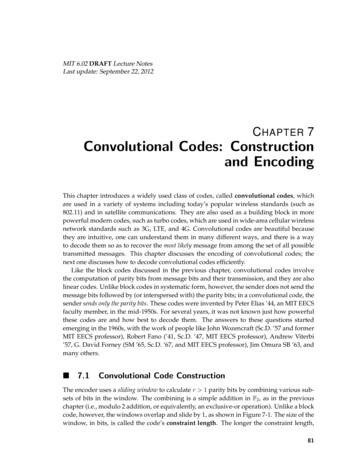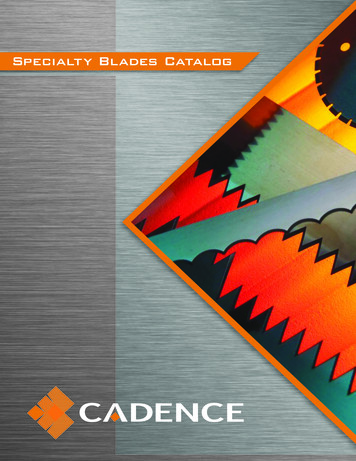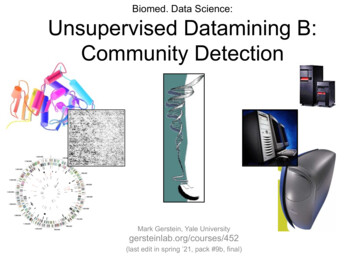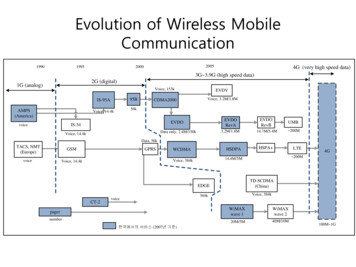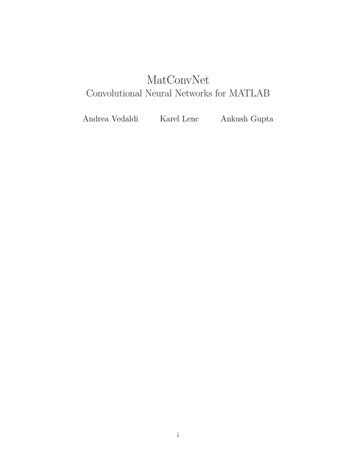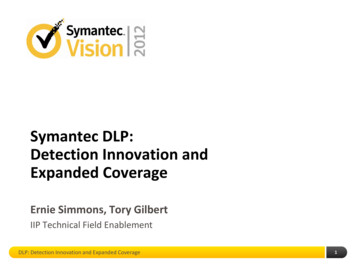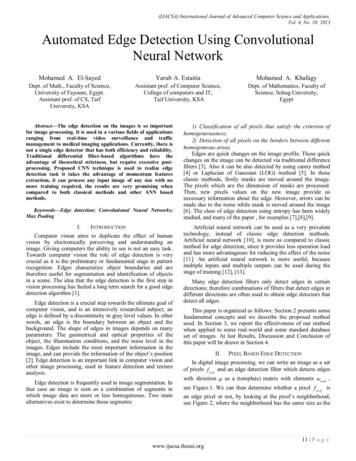
Transcription
(IJACSA) International Journal of Advanced Computer Science and Applications,Vol. 4, No. 10, 2013Automated Edge Detection Using ConvolutionalNeural NetworkMohamed A. El-SayedYarub A. EstaitiaMohamed A. KhafagyDept. of Math., Faculty of Science,University of Fayoum, Egypt.Assistant prof. of CS, TaifUniversity, KSAAssistant prof. of Computer Science,College of computers and IT,Taif University, KSADept. of Mathematics, Faculty ofScience, Sohag University,EgyptAbstract—The edge detection on the images is so importantfor image processing. It is used in a various fields of applicationsranging from real-time video surveillance and trafficmanagement to medical imaging applications. Currently, there isnot a single edge detector that has both efficiency and reliability.Traditional differential filter-based algorithms have theadvantage of theoretical strictness, but require excessive postprocessing. Proposed CNN technique is used to realize edgedetection task it takes the advantage of momentum featuresextraction, it can process any input image of any size with nomore training required, the results are very promising whencompared to both classical methods and other ANN basedmethods.Keywords—Edge detection; Convolutional Neural Networks;Max PoolingI.INTRODUCTIONComputer vision aims to duplicate the effect of humanvision by electronically perceiving and understanding animage. Giving computers the ability to see is not an easy task.Towards computer vision the role of edge detection is verycrucial as it is the preliminary or fundamental stage in patternrecognition. Edges characterize object boundaries and aretherefore useful for segmentation and identification of objectsin a scene. The idea that the edge detection is the first step invision processing has fueled a long term search for a good edgedetection algorithm [1].Edge detection is a crucial step towards the ultimate goal ofcomputer vision, and is an intensively researched subject; anedge is defined by a discontinuity in gray level values. In otherwords, an edge is the boundary between an object and thebackground. The shape of edges in images depends on manyparameters: The geometrical and optical properties of theobject, the illumination conditions, and the noise level in theimages. Edges include the most important information in theimage, and can provide the information of the object’s position[2]. Edge detection is an important link in computer vision andother image processing, used in feature detection and textureanalysis.Edge detection is frequently used in image segmentation. Inthat case an image is seen as a combination of segments inwhich image data are more or less homogeneous. Two mainalternatives exist to determine these segments:1) Classification of all pixels that satisfy the criterion ofhomogeneousness;2) Detection of all pixels on the borders between differenthomogeneous areas.Edges are quick changes on the image profile. These quickchanges on the image can be detected via traditional differencefilters [3]. Also it can be also detected by using canny method[4] or Laplacian of Gaussian (LOG) method [5]. In theseclassic methods, firstly masks are moved around the image.The pixels which are the dimension of masks are processed.Then, new pixels values on the new image provide usnecessary information about the edge. However, errors can bemade due to the noise while mask is moved around the image[6]. The class of edge detection using entropy has been widelystudied, and many of the paper , for examples [7],[8],[9].Artificial neural network can be used as a very prevalenttechnology, instead of classic edge detection methods.Artificial neural network [10], is more as compared to classicmethod for edge detection, since it provides less operation loadand has more advantageous for reducing the effect of the noise[11]. An artificial neural network is more useful, becausemultiple inputs and multiple outputs can be used during thestage of training [12], [13].Many edge detection filters only detect edges in certaindirections; therefore combinations of filters that detect edges indifferent directions are often used to obtain edge detectors thatdetect all edges.This paper is organized as follows: Section 2 presents somefundamental concepts and we describe the proposed methodused. In Section 3, we report the effectiveness of our methodwhen applied to some real-world and some standard databaseset of images. At last Results, Discussion and Conclusion ofthis paper will be drawn in Section 4.II. PIXEL BASED EDGE DETECTIONIn digital image processing, we can write an image as a setof pixels f p , q and an edge detection filter which detects edgeswith direction as a (template) matrix with elements wn ,m ,see Figure.1. We can then determine whether a pixel f p , q isan edge pixel or not, by looking at the pixel’s neighborhood,see Figure 2, where the neighborhood has the same size as the11 P a g ewww.ijacsa.thesai.org
(IJACSA) International Journal of Advanced Computer Science and Applications,Vol. 4, No. 10, 2013edge detector template, say (2 N 1) (2M 1) . We thencalculate the discrete convolution.g p,q NM wn N m Mn,mf p n,q m(1)where f p , q can be classified as an edge pixel if g p ,qexceeds a certain threshold and is a local maximum in thedirection perpendicular to in the image g p ,q . w N ,M . . . w N , M .wN , M wN , M .w0, 0.specificity at the same time. Of course, this idea is not new, butthe concept is both simple and powerful [15]. It combines threearchitectural ideas to ensure some degree of shift, scale anddistortion invariance: local receptive fields, shared weights (orweights replications), and spatial or temporal sub-sampling[16].wn ,m .Fig. 1. A (2 N 1) (2M 1) templateFig. 3. Convolutional Neural Networks structure. f P ,Q . . . w P , Q.f P ,Q . . wP , Q .f p N ,q M.f p N ,q M.f p,q.f p N ,q M.f p N ,q M.Fig. 2. A (2P 1) (2Q 1) image with a (2 N 1) (2M 1) neighborhoodaround f p , q .Some examples of templates for edge detection are:-1-2-1111000000121-1-1-1,0 Sobel, 0 PrewrittThe input plane receive images, each unit in a layerreceives input from a set of units located in a smallneighborhood in the previous layer. With local receptive fields,neurons can extract elementary visual features such as orientededges, end points, corners (or other features such as speechspectrograms).These features are then combined by thesubsequent layers in order to detect higher-order features.IV. PROPOSED TECHNIQUEConvolutional Neural Networks (Convolutiobal NeuralNetwork) are variants of MLPs which are inspired frombiology. From Hubel and Wiesel’s early work on the cat’svisual cortex , we know there exists a complex arrangement ofcells within the visual cortex. These cells are sensitive to smallsub-regions of the input space, called a receptive field, and aretiled in such a way as to cover the entire visual field. Thesefilters are local in input space and are thus better suited toexploit the strong spatially local correlation present in naturalimages. Additionally, two basic cell types have been identified:simple cells (S) and complex cells (C). Simple cells (S)respond maximally to specific edge-like stimulus patternswithin their receptive field. Complex cells (C) have largerreceptive fields and are locally invariant to the exact position ofthe stimulus.a) Sparse Connectivity:Layer M 1The dependency on the edge direction is not very strong;edges with a direction 45 will also activate the edgedetector [14].III. CONVOLUTIONAL NEURAL NETWORKSTypically convolutional layers are interspersed with subsampling layers to reduce computation time and to graduallybuild up further spatial and configurable invariance. A smallsub-sampling factor is desirable however in order to maintainLayer MLayer M-1Fig. 4. A Sparse Connectivity template .12 P a g ewww.ijacsa.thesai.org
(IJACSA) International Journal of Advanced Computer Science and Applications,Vol. 4, No. 10, 2013Convolutional Neural Networks exploit spatially localcorrelation by enforcing a local connectivity pattern betweenneurons of adjacent layers.The input hidden units in the m-th layer are connected to alocal subset of units in the (M -1)-th layer, which have spatiallycontiguous receptive fields. We can illustrate this graphicallyas follows:Imagine that layer M-1 is the input retina. In the above,units in layer m have receptive fields of width 3 with respect tothe input retina and are thus only connected to 3 adjacentneurons in the layer below (the retina). Units in layer m have asimilar connectivity with the layer below. We say that theirreceptive field with respect to the layer below is also 3, buttheir receptive field with respect to the input is larger (it is 5).The architecture thus confines the learnt “filters”(corresponding to the input producing the strongest response)to be a spatially local pattern (since each unit is unresponsive tovariations outside of its receptive field with respect to theretina). As shown above, stacking many such layers leads to“filters” (not anymore linear) which become increasingly“global” however (i.e. spanning a larger region of pixel space).For example, the unit in hidden layer M 1 can encode a nonlinear feature of width 5 (in terms of pixel space) [17].b) Shared Weights Neural Network:Hidden units can have shift windows too this approachresults in a hidden unit that is translation invariant. But nowthis layer recognizes only one translation invariant feature,what can make the output layer unable to detect some desiredfeature. To fix this problem, we can add multiple translationinvariant hidden layers:InputHiddenOutputLayerLayerLayerA full connected neural network is not a good approachbecause the number of connections is too big, and it is hardcoded to only one image size. At the learning stage, we shouldpresent the same image with shifts otherwise the edge detectionwould happen only in one position (what was useless).Exploring properties of this application we assume: Theedge detection should work the same way anywhere the inputimage is placed. This class of problem is called TranslationInvariant Problem. The translation invariant property leads tothe question: why to create a full connected neural network?There is no need to have full connections because we alwayswork with finite images .The farther the connection, the lessimportance to the computation [18].c) Max PoolingAnother important concept of Convolutional NeuralNetworks is that of max-pooling, which a form of non-lineardown-sampling is. Max-pooling partitions the input image intoa set of non-overlapping rectangles and, for each such subregion, outputs the maximum value. Max-pooling is useful invision for two reasons:1) It reduces the computational complexity for upperlayers.2) It provides a form of translation invariance.To understand the invariance argument, imagine cascadinga max-pooling layer with a convolutional layer. There are 8directions in which one can translate the input image by asingle pixel. If max-pooling is done over a 2x2 region, 3 out ofthese 8 possible configurations will produce exactly the sameoutput at the convolutional layer. For max-pooling over a 3x3window, this jumps to 5/8. Since it provides additionalrobustness to position, max-pooling is thus a “smart” wayof reducing the dimensionality of intermediate representations[19].a) graphical depiction of a model:Sparse, Convolutional layers and max-pooling are at theheart of the Convolutional Neural Network models. While theexact details of the model will vary greatly, Figure 6 shows agraphical depiction of a model.Implementing the network shown in Figure 3, the inputimage is applied recursively to down-sampling layers reducesthe computational complexity for upper layers and reduce thedimension of the input, also the network has a 3x3 receptivefields that process the sup sampled input and output the edgedetected image, the randomly initialized model acts very muchlike an edge detector as shown in Figure 7.SharedSharedWeightsWeightsFig. 5. Shared Weight Neural Network Edit imageThe hidden layers activate for partial edge detection,somehow just like real neurons described in Eye, Brain andVision (EBV) from David Hubel. Probably there is not “sharedweights” in brains neurons, but something very near should beachieved with the presentation of patterns shifting along ourfield of view [20].13 P a g ewww.ijacsa.thesai.org
(IJACSA) International Journal of Advanced Computer Science and Applications,Vol. 4, No. 10, 2013Fig. 7. Output of randomly initialized networkThe training of Convolutiobal Neural Networks is verysimilar to the training of other types of NNs, such as ordinaryMLPs. A set of training examples is required, and it ispreferable to have a separate validation set in order to performcross validation and “early stopping” and to avoid overtraining.To improve generalization, small transformations, such as shiftand distortion, can be manually applied to the training set.Consequently the set is augmented by examples that areartificial but still form valid representations of the respectiveobject to recognize. In this way, the Convolutiobal NeuralNetwork learns to be invariant to these types oftransformations. In terms of the training algorithm, in general,online Error Backpropagation leads to the best performance ofthe resulting Convolutiobal Neural Network [21].The training patterns for the neural network are shown inFigure 8. Totally 17 patterns are considered, including 8patterns for "edge" and 9 patterns for "non-edge". Duringtraining, all 17 patterns are randomly selected. For simplicity,all training patterns are binary images.Fig. 8. Edge and non edge Training PatternsV.EXPERIMENT DISCUSSIONThe training process passes many stage according totraining epoch's number to reach the weight values that givesthe best result, the epoch's number value ranges from 100epoch to 100000 epoch as a maximum number performed. ThePSNR (peak signal-to-noise ratio) is used to evaluate thenetwork output during raising the epoch's number.The following Figure 9 shows the output result and itsPSNR value to a test Lena image at different statuses of epoch'snumber value.Fig. 6. Full Model of Convolutional Neural networkFigure 9 shows the changes of the edge detected outputimage of the proposed technique, it is obvious that the best14 P a g ewww.ijacsa.thesai.org
(IJACSA) International Journal of Advanced Computer Science and Applications,Vol. 4, No. 10, 2013result that gathers more expected edge pixels with least noise,PSNR 5.33dB is reached when network was trained100000 times, what approves the validity and efficiency of ourproposed technique, the following Figure 10 shows the changesof the noise ratio in the output edge detected Lena image whenapplied to the proposed system during increasing the trainingepochs number from 400 to 100000 epoch, a significantchanges occurred when we raised the epoch number to itsmaximum value.Original Imageepochs 400,epochs 500,PSNR 5.71 dBPSNR 5.72 dBFig. 10. PSNR changes during TrainingVI.SIMULATION RESULTSThe Convolutional Neural Network model presented inFigure 1 is implemented using VC and trained using sharpedge images several times to increase its ability toautomatically detect edges in any test image with a variantresolution, results are compared with classical edge detectorssuch as (Sobel, Canny, LOG, Prewitt) and technique proposedby [19] that presented a combined of entropy and pulse coupledNeural Network model for edge detection as in Figure 10:epochs 600,epochs 800,epochs 1000,PSNR 5.70dBPSNR 5.69 dBPSNR 5.70 dBOriginal imageepochs 5000,epochs 10000,epochs 100000,PSNR 5.71 dBPSNR 5.70 dBPSNR 5.33 dBCanny, PSNR 2.5 dBFig. 9. output and PSNR values for different network statuesThe results show that the best result is obtained when thetest image is applied for the maximum epochs trained networkeither by the output result image intensity or the PSNR value.Sobel, PSNR 2.34 dBdBPrewitt,PSNR 2.4415 P a g ewww.ijacsa.thesai.org
(IJACSA) International Journal of Advanced Computer Science and Applications,Vol. 4, No. 10, 2013LOG, PSNR 2.34 dBChen[17]PSNR 2.65 dB,Original imageProposed, PSNR 2.3 dBFig. 11. comparison of different techniques Vs proposed technique.It is obvious to notice from Figure 11 that proposedtechnique achieves edge detection process efficiently comparedwith different known methods, where it gathers more expectededge pixels and left a little bit noise than other techniques asshown in Figure 12.Output result image with a10000 epochs trained networkOutput result image with a100000 epochs trained networkFig. 13. output result for modern house imageFig. 12. PSNR values compared.One of the main advantages of proposed technique it that itperforms well when applied to high resolution and live imagesthe following figure 12 shows the result for a modern houseimage with size 1024x711 pixels. This approach performs wellwith common standard images, high resolution size and liveimages.VII. CONCLUSIONThe Convolutional Neural Network is used as an edgedetection tool. It was trained with different edge and non edgepatterns several times so that it is able to automatically detectedges in any test image efficiently.The proposed technique applied for standard images suchas Lena, and Cameraman, also live non standard images withdifferent size, resolution, intensity, lighting effects and otherconditions. The technique shows a good performance whenapplied on all test images.16 P a g ewww.ijacsa.thesai.org
(IJACSA) International Journal of Advanced Computer Science and Applications,Vol. 4, No. 10, 2013REFERENCESM. Norgaard, N.K. Poulsen, O. Ravn, “Advances in derivative-free stateestimation for non-linear systems,” Technical Report IMM-REP-199815 (revised edition), Technical University of Denmark, Denmark, April2000.[2] L. Canny, “A computational approach to edge detection”, IEEE Trans.on Pattern Analysis and Machine Intelligence, vol. 8 no. 1, pp. 679-698,1986.[3] D. Marr, E. Hildreth, “Theory of edge detection”, Proc. of Royal SocietyLandon, B(207): 187-217, 1980.[4] R. Machuca,. “Finding edges in noisy scenes”, IEEE Trans. on PatternAnalysis and Machine Intelligence, 3: 103-111, 1981.[5] F. Rosenblatt, “The Perceptron: A Probabilistic Model for InformationStorage and Organization in the Brain”, Cornell AeronauticalLaboratory, Psychological Review, v65, No. 6, pp. 386-408, 1958.[6] A. J. Pinho, L. B. Almeida, “Edge detection filters based on artificialneural networks”, Pro. of ICIAP'95, IEEE Computer Society Press,p.159-164, 1995.[7] Mohamed A. El-Sayed and Mohamed A. Khafagy, “Using Renyi'sEntropy For Edge Detection In Level Images”, International Journal ofIntelligent Computing and Information Science (IJICIS) Vol. 11, No.2,pp. 1-10, 2011.[8] Mohamed A. El-Sayed , “Study of Edge Detection Based On 2DEntropy”, International Journal of Computer Science Issues (IJCSI)ISSN : 1694-0814 , Vol. 10, Issue 3, No 1, pp. 1-8, 2013.[9] Mohamed A. El-Sayed , S. F.Bahgat , and S. Abdel-Khalek “NovelApproach of Edges Detection for Digital Images Based On HybridTypes of Entropy”, International Appl. Math. Inf. Sci. 7, No. 5,pp.1809-1817 , 2013.[10] H.L. Wang, X.Q. Ye, W.K. Gu, “Training a NeuralNetwork for MomentBased Image Edge Detection” Journal of Zhejiang UniversitySCIENCE(ISSN 1009-3095, Monthly), Vol.1, No.4, pp. 398-401CHINA, 2000.[11] Y. Xueli, “Neural Network and Example”, Learning, Press of Railway ofChina, Beijing, 1996.[1][12] P.K. Sahoo, S. Soltani,A.K.C. Wong, Y.C. Chen,"A Survey of theThresholding Techniques", Computer Vision Graphics Image Process,1988.[13] Y. LeCun,L.Bottou,Y.Bengio, and P.Haffner.“Gradient-based learningapplied to document recognition”, Proceedings of the IEEE, vol. 86, pp.2278–2324, November 1998.[14] Jake Bouvrie “Notes on Convolutional Neural Networks” Center forBiological and Computational Learning Department of Brain andCognitive Sciences Massachusetts Institute of Technology Cambridge,MA 02139, 2006.[15] van der Zwaag, B.J. and Slump, C.H. and Spaanenburg , L, ”Analysis ofneural networks for edge detection”, In:13th Annual Workshop onCircuits Systems and Signal Processing (ProRISC), 28-29 November2002.[16] Honglak Lee; "Tutorial on Deep Learning and Applications", NIPSWorkshop on Deep Learning and Unsupervised Feature Learni, 2010.[17] Sumedha, Monika Jenna, "Morphological Shared Weight NeuralNetwork: A method to improve fault tolerance in Face"; InternationalJournal of Advanced Research in Computer Engineering & TechnologyVolume 1, Issue 1, March 2012.[18] Jawad Nagi , Frederick Ducatelle , Gianni A. Di Caro , Dan Cires an ,Ueli Meier , Alessandro Giusti ,Farrukh Nagi , Jurgen Schmidhuber ,Luca Maria Gambardella; "Max-Pooling Convolutional NeuralNetworks for Vision-based Hand Gesture Recognition" Internationalconference on signal and image processing applications, 2011.[19] ranzato; "Deep learning documentation: Convolutional NeuralNetworks" Copyright 2008--2010, LISA lab. Last updated on Dec 03,2012[20] Stefan Duffner “Face Image Analysis With Convolutional NeuralNetworks”, 2007.[21] Jiansheng Chen, Jing Ping Heand Guangda Su, “Combining imageentropy with the pulse coupled neural network in edge detection” , ICIP2010.17 P a g ewww.ijacsa.thesai.org
therefore useful for segmentation and identification of objects in a scene. The idea that the edge detection is the first step in vision processing has fueled a long term search for a good edge detection algorithm [1]. Edge detection is a crucial step towards the ultimate goal of computer vision, and is an intensively researched subject; an
